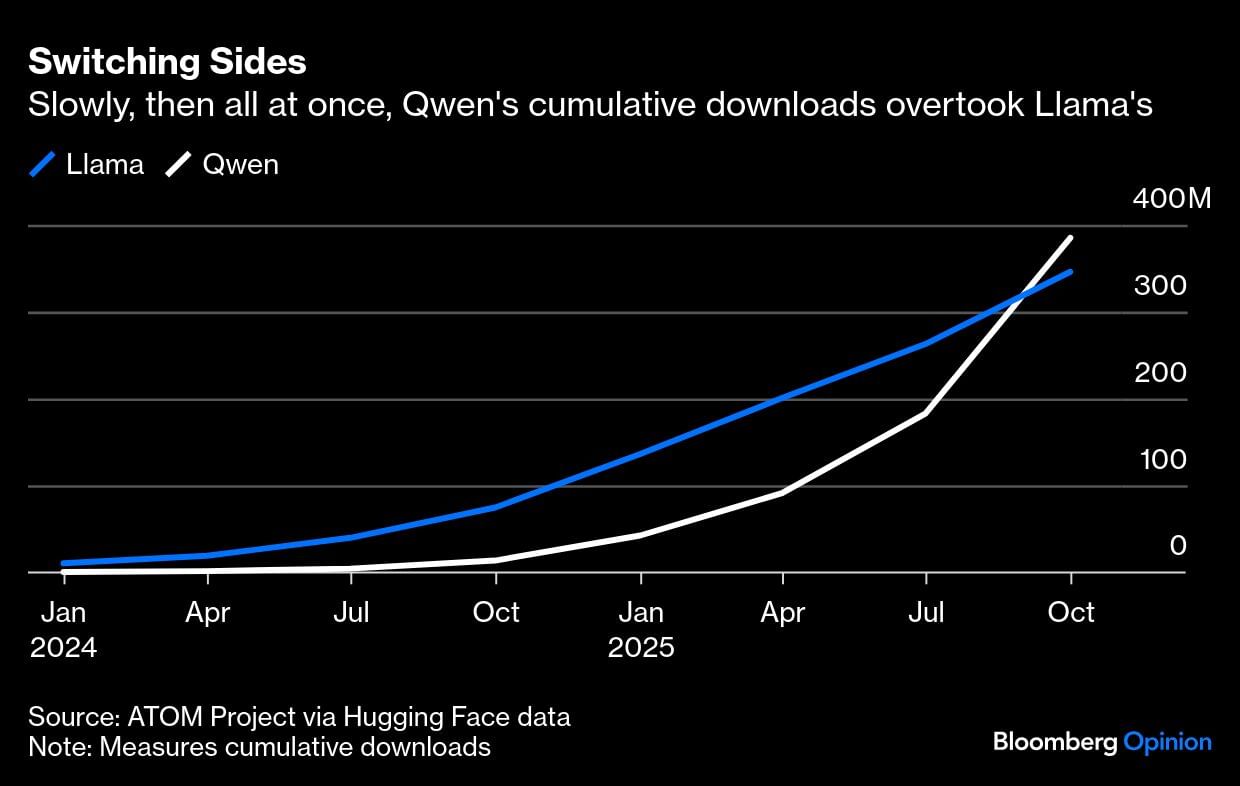Nvidia Corp. Chief Executive Officer Jensen Huang recently declared to the Financial Times that: “China is going to win the AI race.” He later softened his stance, saying the US’s rival was merely “nanoseconds behind,” and that it’s vital America comes out on top “by racing ahead and winning developers worldwide.”
Huang’s initial assessment is simplistic, and the motives for his negativity about the US are transparent. He has spent the past year arguing that America benefits from his company selling chips to the Chinese market despite Washington’s encroaching export controls. But he is right to worry that the battle for developers may already be slipping away.
In recent weeks, a subtle shift has become increasingly apparent. Speculation has been stirring for months that low-cost, open-source Chinese AI models could lure global users away from US offerings. But now it appears they are also quietly winning over Silicon Valley.
Venture capitalist Chamath Palihapitiya recently said on his influential All-In podcast — co-hosted by White House AI czar David Sacks — that a company he works with has offloaded major workloads to Kimi K2, developed by Beijing-based Moonshot AI. The open-source model, he said, is “frankly just a ton cheaper than OpenAI and Anthropic.”
Shortly after, Airbnb Inc. CEO Brian Chesky admitted that he didn’t integrate his travel app with OpenAI’s ChatGPT because the connective tools weren’t “quite ready.” Airbnb’s new service agent leans on more than a dozen different AI models, Chesky said. They are “relying a lot” on Alibaba Group Holding Ltd.’s Qwen lineup: “It’s very good. It’s also fast and cheap.” His comments are especially notable given Chesky’s close personal relationship with OpenAI CEO Sam Altman.
The list of overt acknowledgements is growing. Thinking Machines Lab, the startup founded by OpenAI’s former Chief Technology Officer Mira Murati, said in a blogpost that its latest research was inspired by and built upon the work of Alibaba’s Qwen3 team.
But what might be more interesting are the more subtle ways this shift appears to be taking root. Cursor, a much-hyped AI coding leader valued at some $10 billion, released a new version of its assistant last month. Internet conjecture has since mounted that it was built on top of a Chinese AI tool like DeepSeek, after a tech investor pointed out on X that it switched its inner monologue to Mandarin while he was using it.
Another hot US-based company, Cognition AI Inc., also valued at around $10 billion, appears to have built its new coding agent off a base model from Zhipu AI, known internationally as Z.ai. After social media sleuths posted about their suspicions, the Beijing-based firm seemed to confirm their findings in a tweet, saying it “highlights the positive impact and value of open-source contributions to the ecosystem.” Both US companies didn’t immediately respond to my emailed requests for comment. But the permissive licensing nature of Chinese AI models means that they are free for companies to build products on top of.
Data from Hugging Face’s platform compiled by the ATOM Project, a US coalition in support of open-source AI, confirmed that. Chinese models have overtaken the US in terms of cumulative downloads by developers. The shift happened slowly, then all at once: In early 2024, Meta Platforms Inc.’s Llama had 10.6 million downloads to Alibaba Qwen’s meager half a million. By last month, Qwen had had 385.3 million cumulative downloads compared to Llama’s 346.2 million. And derivative systems built on Qwen now account for more than 40% of new language models posted on Hugging Face, while Meta’s share has fallen to 15%.
There have been geopolitical concerns about international users flocking to Chinese AI tools, specifically the potential for Communist Party ideologies to be embedded in outputs. But for developers racing to ship products, especially in the coding and software development sectors, these risks become less of a concern — especially when weighing for price and performance. Open models can also be downloaded, fine-tuned and run locally, mitigating content and data privacy anxieties.

It’s premature for Huang to declare a winner. The US still has clear advantages when it comes to access to cutting-edge chips and computing power, critical components in developing advanced systems. But Beijing’s low-cost and open-source push is undoubtedly attracting developers, the backbone of AI innovation.
If Washington truly wants to come out on top in the long run, it should start by asking why Silicon Valley is already switching sides.
This column reflects the personal views of the author and does not necessarily reflect the opinion of the editorial board or Bloomberg LP and its owners.
Catherine Thorbecke is a Bloomberg Opinion columnist covering Asia tech. Previously she was a tech reporter at CNN and ABC News.
Disclaimer: This report is auto generated from the Bloomberg news service. ThePrint holds no responsibility for its content.






